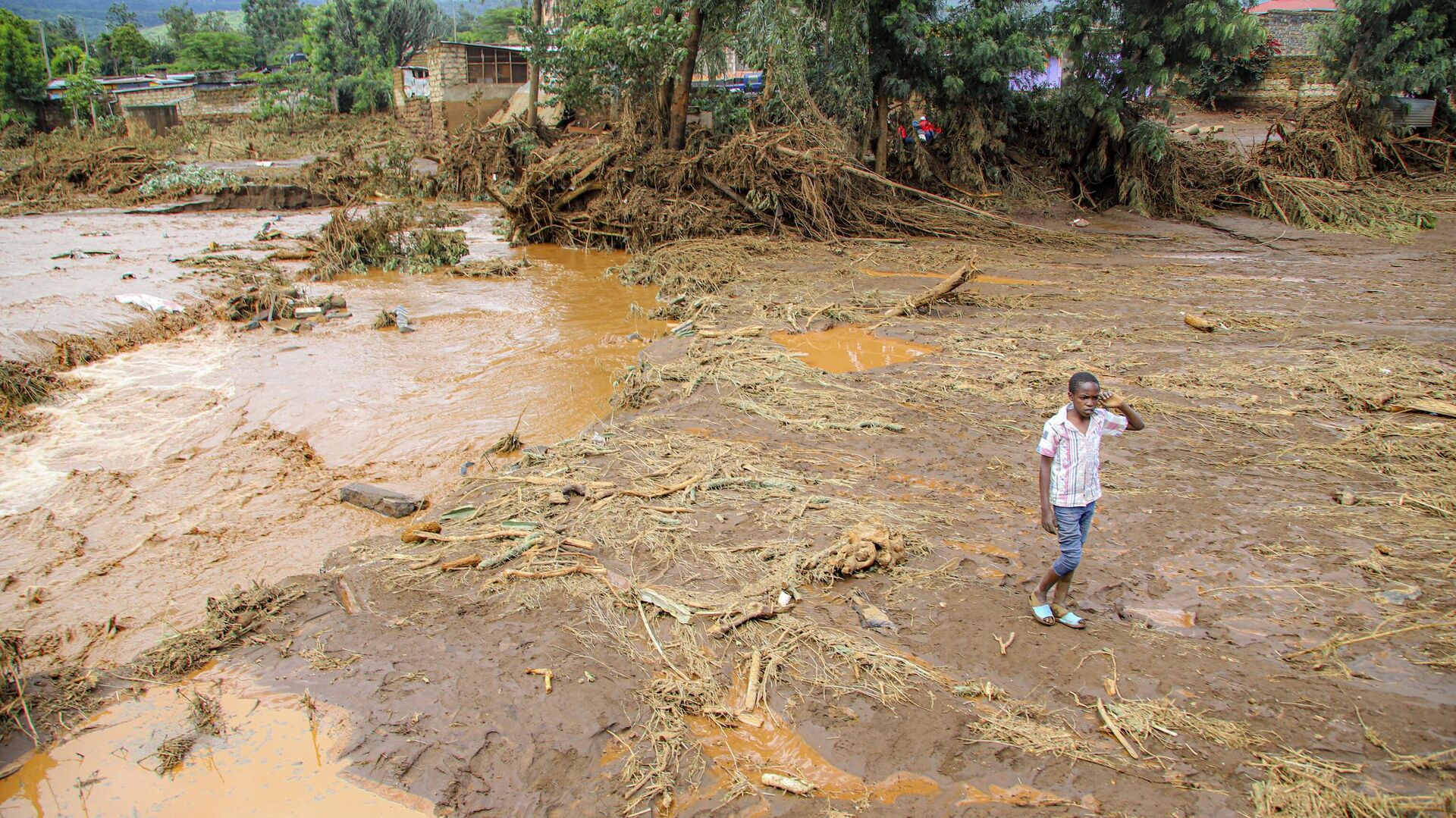https://en.sputniknews.africa/20240502/what-causes-deadly-floods-in-kenya-and-east-africa-in-general-1066332098.html
What Causes Deadly Floods in Kenya and East Africa in General?
What Causes Deadly Floods in Kenya and East Africa in General?
Sputnik Africa
Kenya has been hit by some of its worst flooding since March, with at least 188 people killed, according to the country's interior ministry. More victims are... 02.05.2024, Sputnik Africa
2024-05-02T15:04+0200
2024-05-02T15:04+0200
2024-05-02T15:17+0200
features
floods
kenya
indian ocean
east africa
united nations (un)
antonio guterres
ocean
world meteorological organization (wmo)
sputnik africa
https://cdn1.img.sputniknews.africa/img/07e8/05/02/1066334248_0:161:3071:1888_1920x0_80_0_0_ae80e0bcf0e8f15c5aa4e6a5cecd6cee.jpg
Flooding affected not only Kenya but also the whole of East Africa. On Wednesday, UN Secretary General Antonio Guterres said he was worried over the high number of deaths as a result of heavy flooding in the region.But what are the reasons why we hear more and more often about terrible floods in different parts of Africa? Sputnik Africa tried to figure this out.Rainy SeasonsThe seasonal patterns are one of the factors. Africa is characterized by rainy seasons alternating with periods of no rain. In Kenya and several other eastern parts of the continent, the "long rains" season runs from March to May, while the "short rains" season runs from October to December.Most of the average yearly rainfall in the nation is attributed to the "long rains" season. Often, it is marked by intense downpours that might last into June.But in its "long rains" season forecast for this year, the Kenya Meteorological Department said that above-average rainfall will hit several areas of the nation, with some seeing periodic storms. Along with other implications, he cautioned against mudflows, landslides, and flash floods.Severe storms also marked the brief monsoon season of last year, particularly in November, in numerous regions of the country. The meteorological agency reported that several regions had over three times the long-term average rainfall.Indian Ocean DipoleThese natural cycles are, in turn, influenced by other larger patterns. In Kenya’s case, it’s the Indian Ocean Dipole, which is a shifting of sea surface temperatures that causes the western Indian Ocean to be warmer than normal and then colder than average than the eastern Indian Ocean. There are also stages to it — positive, neutral, and negative. During the positive phase, there is a significant increase in rains in regions located to the west of the Indian Ocean, including Kenya. So, it is quite likely that the positive Indian Ocean Dipole combined with climate change is to blame for Kenya's continuous flood-causing rainfall, the media reported, citing Joyce Kimutai, a research associate at Imperial College London.She further explained that increased evaporation of warmer waters brought on by the hotter atmosphere can result in more intense rains.Moreover, in December of last year, Kimutai and colleagues from World Weather Attribution — a group of scientists that examines whether climate change contributes to extreme weather —found that the "short rains" season in Kenya and other eastern African countries was up to twice as intense last year due to human-caused climate change.El NinoBut that's not all: according to the UN, the situation is aggravated by El Nino, a naturally occurring phenomenon that significantly influences the world climate. This time it began in mid- to late 2023 and was one of the strongest in record history, according to the World Meteorological Organization (WMO).Add the phenomenon of rainy seasons, the Indian Ocean Dipole and climate change, and you have a recipe for disaster.However, these phenomena can be predicted "well in advance," which can help reduce their consequences, Saulo added.In the meantime, the country has to cope with the current crisis, which the Kenya Meteorological Department predicts will last until June.
https://en.sputniknews.africa/20240501/kenyan-president-ruto-visits-flood-victims-urges-them-to-evacuate-before-too-late-1066313268.html
kenya
indian ocean
east africa
ocean
Sputnik Africa
feedback@sputniknews.com
+74956456601
MIA „Rossiya Segodnya“
2024
Christina Glazkova
https://cdn1.img.sputniknews.africa/img/07e7/0b/07/1063380906_0:0:673:674_100x100_80_0_0_79628b4d0cd9f29291a57aa13bbf9e7a.jpg
Christina Glazkova
https://cdn1.img.sputniknews.africa/img/07e7/0b/07/1063380906_0:0:673:674_100x100_80_0_0_79628b4d0cd9f29291a57aa13bbf9e7a.jpg
News
en_EN
Sputnik Africa
feedback@sputniknews.com
+74956456601
MIA „Rossiya Segodnya“
Sputnik Africa
feedback@sputniknews.com
+74956456601
MIA „Rossiya Segodnya“
Christina Glazkova
https://cdn1.img.sputniknews.africa/img/07e7/0b/07/1063380906_0:0:673:674_100x100_80_0_0_79628b4d0cd9f29291a57aa13bbf9e7a.jpg
floods, kenya, indian ocean, east africa, united nations (un), antonio guterres, ocean, world meteorological organization (wmo) , sputnik africa, disaster, natural disaster, monitoring disasters, climate change, climate, weather, international, el nino
floods, kenya, indian ocean, east africa, united nations (un), antonio guterres, ocean, world meteorological organization (wmo) , sputnik africa, disaster, natural disaster, monitoring disasters, climate change, climate, weather, international, el nino
What Causes Deadly Floods in Kenya and East Africa in General?
15:04 02.05.2024 (Updated: 15:17 02.05.2024) Christina Glazkova
Writer / Editor
Kenya has been hit by some of its worst flooding since March, with at least 188 people killed, according to the country's interior ministry. More victims are expected as the rains continue.
Flooding affected not only Kenya but also the whole of East Africa. On Wednesday, UN Secretary General Antonio Guterres
said he was worried over the high number of deaths as a result of heavy flooding in the region.
“The Secretary-General is deeply distressed to hear of the hundreds of lives lost and many others affected by heavy flooding in Burundi, Kenya, Somalia and Tanzania and other parts of East Africa,” the statement said.
But what are the reasons why we hear more and more often about
terrible floods in different parts of Africa?
Sputnik Africa tried to figure this out.
The seasonal patterns are one of the factors. Africa is characterized by rainy seasons alternating with periods of no rain. In Kenya and several other eastern parts of the continent, the "long rains" season runs from March to May, while the "short rains" season runs from October to December.
Most of the average yearly rainfall in the nation is attributed to the "long rains" season. Often, it is marked by intense
downpours that might last into June.
But in its "long rains" season forecast for this year, the Kenya Meteorological Department
said that above-average rainfall will hit several areas of the nation, with some seeing periodic storms. Along with other implications, he cautioned against mudflows,
landslides, and flash floods.
Severe storms also marked the brief monsoon season of last year, particularly in November, in numerous regions of the country. The meteorological agency reported that several regions had over three times the long-term average rainfall.
These natural cycles are, in turn, influenced by other larger patterns. In Kenya’s case, it’s the Indian Ocean Dipole, which is a shifting of sea surface temperatures that causes the western Indian Ocean to be warmer than normal and then colder than average than the eastern Indian Ocean. There are also stages to it — positive, neutral, and negative.
During the positive phase, there is a significant increase in rains in regions located to the west of the Indian Ocean, including Kenya. So, it is quite likely that the positive Indian Ocean Dipole combined with
climate change is to blame for Kenya's continuous flood-causing rainfall, the media reported, citing Joyce Kimutai, a research associate at Imperial College London.
She further explained that increased evaporation of warmer waters brought on by the hotter atmosphere can result in more intense rains.
Moreover, in December of last year, Kimutai and colleagues from World Weather Attribution — a group of scientists that examines whether climate change contributes to extreme weather —
found that the "short rains" season in Kenya and other eastern African countries was up to twice as intense last year due to human-caused climate change.
But that's not all:
according to the UN, the situation is aggravated by El Nino, a naturally occurring phenomenon that significantly influences the world climate. This time it began in mid- to late 2023 and was one of the strongest in record history, according to the World Meteorological Organization (WMO).
"El Nino has been a source of extreme weather patterns globally. These have the effect of undoing decades of developmental progress [...]," said UN General Assembly President Dennis Francis.
Add the phenomenon of rainy seasons, the Indian Ocean Dipole and climate change, and you have a recipe for disaster.
“In parallel, human-induced climate change is intensifying the impacts of El Nino/La Nina episodes and increasing climate risks,” WMO Secretary-General Celeste Saulo noted.
However, these phenomena can be predicted "well in advance," which can help reduce their consequences, Saulo added.
In the meantime, the country has to cope with the current crisis, which the Kenya Meteorological Department predicts will last until June.



